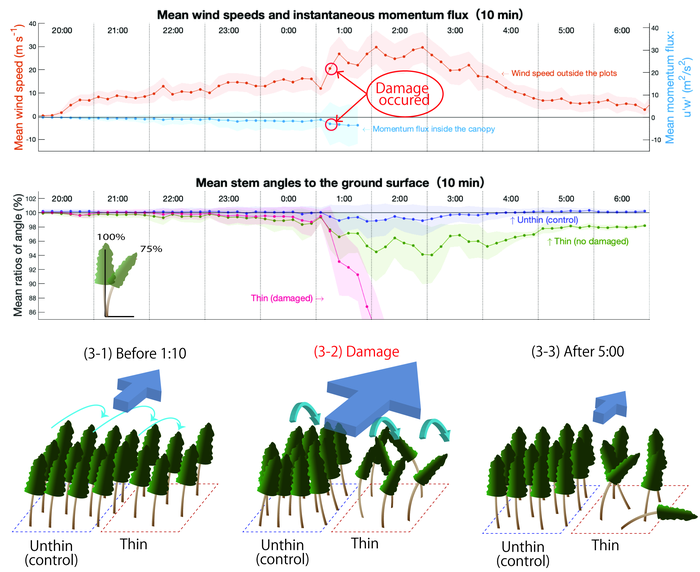Strong winds can cause damage to trees in the forest. In spite of extreme weather events becoming more prevalent, researchers have not completely understood why some trees are damaged while other trees survive.

Image Credit: Kana Kamimura, Shinshu University.
A research group headed by Dr. Kana Kamimura of Shinshu University has been successful in achieving special data when a forest under an ongoing study got struck by the category-5 tropical cyclone Trami in 2018. This provided them with previously undocumented data: dynamic reactions of trees damaged by wind.
Forest wind damage is expected to increase as the climate changes, not just in the current tropical cyclone-affected regions, but also in much larger areas with trees that have never experienced such extreme conditions.
Tropical cyclones are anticipated to migrate north (in the northern hemisphere) while also increasing in magnitude. To safeguard forests in a better way, which have significant economic value and contribute to the wellbeing of the ecosystem by offering forest resources, a place for leisure, and carbon sinks, a better understanding is needed of how trees and forests survive extreme weather caused by global warming.
As soon as trees encounter powerful wind turbulence surpassing their stability, they fail. Strong winds tend to damage forests, but not all trees are uprooted or broken on the stem.
Until recently, it has been assumed that the mechanism by which trees fail is caused simply by pressure from wind turbulence on the canopy, which causes tree oscillations, and then the accumulated stress causes stem or root failure. This research makes a significant contribution to closing the gap between current knowledge and actual wind-damage processes in forests.
Two plots in sugi tree (Cryptomeria japonica) planted forests were utilized for this study: unthinned plots that were the control and thinned plots that have a bigger distance between trees. The scientists discovered that the control plot had no damage while the thinned plot had few damaged trees.
But the trees that were not damaged in the thinned plot were leaned, never going back to their original vertical positions. All trees in both plots must have received similar pressure from wind turbulence simultaneously; so why did a few trees survive and not others?
In this study, the trees were fitted with sensors to monitor stem strains and crown positions. The scientists were able to gather data from both trees that survived and trees that failed. Similarities and variations of the tree oscillations within and between the various plots were examined.
Noticing the crown sway data of all trees together, Dr. Kamimura identified that the trees in the control plot helped each other to discharge strong pressure by constantly crushing their crowns, whereas the trees in the thinned plots had to separately withstand the pressure without any help from the neighboring trees. This is due to the distance between the trees.
Otherwise stated, the control plot developed resilience collectively and the trees in the thinned plot had to withdraw powerful pressures alone.
This answers the often discussed question of why trees in forests soon after thinning become more susceptible to powerful winds. The thinning makes the distance between trees greater and converts forests into groups of single trees. This reduces the chance of crown collisions that serve as a buffer of energy transfer to the roots.
How the trees are distanced changes the probability of the tree’s survival since the various levels of support are offered by neighboring trees. Controlling tree spacing can be done via forest management; hence, forest damage risk could be decreased even under climate change conditions.
Additional study of diverse forest settings would offer more clues as to how forests have survived for millennia and what people can do for forests in changing climates.
Journal Reference:
Kamimura, K., et al. (2022) Tree dynamic response and survival in a category-5 tropical cyclone: The case of super typhoon Trami. Science Advances. doi.org/10.1126/sciadv.abm7891.